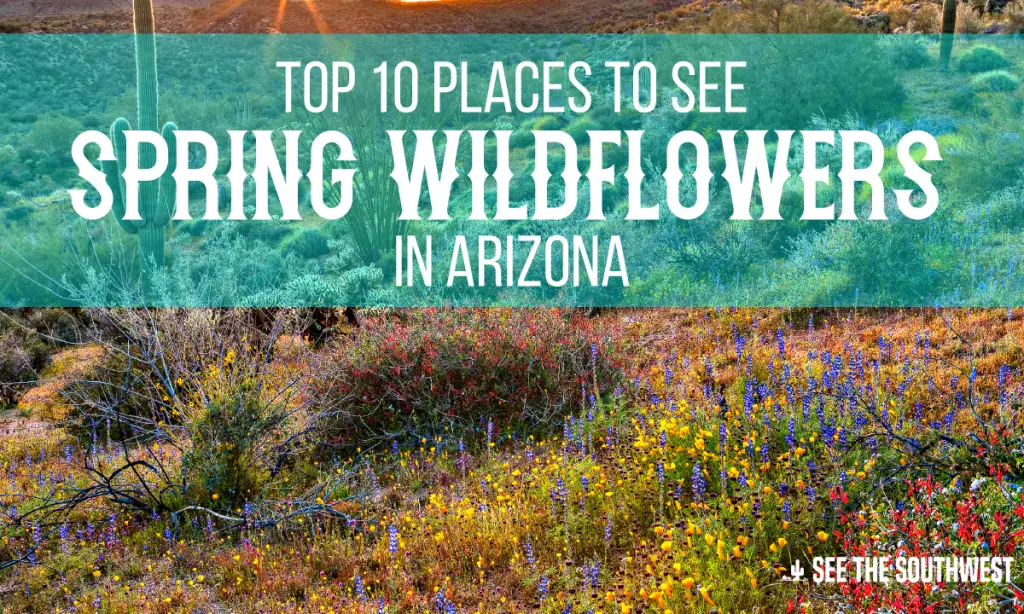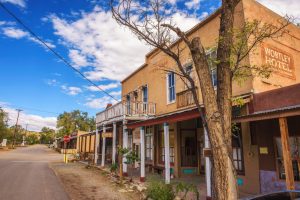
Who would guess that in the Spring, wildflowers bloom in profusion, even in the deserts areas of Arizona? Yet Arizona is famous for its yearly displays of color. However, there are two distinct wildflowers seasons, owing to the ranges in altitude. Therefore, we’ve broken this article into two sections — the top 5 place to see desert wildflowers (which bloom in March) and the top 5 places to see mountain wildflowers (which bloom in April and May).
Top 5 Place to see Desert Wildflowers
Thanks to the lovely weather in the valleys and deserts of Arizona during the winter months, wildflowers season comes early to these areas. In early March, when the temperatures begin to climb into the high 70s and low 80s, life begins to stir. The top five wildflowers you are likely to see in the desert areas of Arizona are:
- Mexican gold poppy: Known for its showy gold blooms, the Mexican poppy is found below elevations of 4,500 feet.
- Desert lupine: These violet-blue blooms are often seen growing amid Mexican poppy. They are found below 3,000 feet.
- Brittlebush: This shrub’s yellow blooms add to spring color.
- Desert marigold: These yellow flowers are found below 5,000 feet, often along roadsides and slopes.
- Firecracker penstemon: These red flowers are found throughout the West at elevations from 3,000 to 11,000 feet.
The Superstition Mountains
Located 40 miles east of downtown Phoenix, the Superstition Wilderness is a fantastic place to view the desert in bloom — Mexican Poppies and Lupine abound, particularly after a wet winter. Peralta Canyon on the Northeast side of the range, offers a fantastic trial up to Fremont Saddle with a fantastic overlook of the iconic landmark known as Weaver’s Needle. But you don’t have to be a hiker to appreciate the wildflowers … just driving into the wilderness area is enough. Be aware the access to the area is by gravel roads, which are fairly well maintained, but can be rough at times. On the northwest side, Lost Dutchman State Park has dozens of terrific trails you can follow to explore the wildflowers, as well as picnic and camping areas.
Bartlett Lake
Located 48 miles northeast of downtown Phoenix, Bartlett Lake offers an explosion of Mexican Poppies early in the season, with various other cactus and succulents coming into bloom from March through late May. Whole hillside blaze orange, especially after a wet winter. The drive to Bartlett Lake is paved and the area offers fantastic picnic areas, the marina, and great hiking trails.
Picacho Peak
The site of Arizona’s only Civil War battle, Picacho Peak State Park, also explodes with color during wildflower season. Located between Tucson and Casa Grande, the park is easily accessible from Interstate 10. The prominent 1,500-foot summit is the only mountain in the area, so it is distinctive. Hiking Picacho Peak (though extremely strenuous) provides exquisite views of the Catalina Mountains to the south, as well as an expansive view of the desert all around. The park facilities include a visitor center with exhibits and a gift store, hiking trails, playground, historical markers, campground (with or without electric), picnic areas, ramadas, grills, dump station, restrooms, and showers. In early March, a reenactment of the Civil War battle takes place each year.
The Desert Botanical Garden
The Desert Botanical Garden, located in Papago Park in Phoenix, offers more than 20,000 desert plants, with emphasis on those native to the Sonoran Desert of Arizona. Their internationally acclaimed collection provides a delight for the senses and spirit as well as insight into fragile ecosystems. In Spring, the garden comes alive with wildflowers.
Saguaro National Park
Saguaro National Park near Tucson boasts over 165 miles of hiking trails, weaving among the largest concentration of saguaro cacti in the world. In early to late March, the wildflowers along the desert floor burst into bloom. In April or May the saguaro themselves bloom. Common wildlife include the coyote, Gambel’s quail, and desert tortoise, all of which are a delight to view in their natural habitat.
Top 5 Places to see Mountain Wildflowers
The higher ground in Arizona loses its winter chill more slowly. Wildflower season runs from late March through May and even early June, depending on the altitude. In the mountains, the wildflowers range from:
- Silvery lupine: Violet, pea-like flowers are arranged in a showy spike, up to 8 in. long, atop the stems.
- Richardson’s geranium: Flowers are usually white to pink colored with purple veins and five petals.,
- Firecracker penstemon: These red flowers are found throughout the West at elevations from 3,000 to 11,000 feet.
- Purplewhite owl’s-clover: This plant produce tall spikes of deep purple to white flowers.
- Red baneberry: Have small white petals, showy stamens, and a rose-like fragrance; borne in a fluffy cluster.
1. Boyce Thompson Arboretum State Park
Boyce Thompson Arboretum State Park, located in Superior, is Arizona’s oldest and largest botanical garden. During the wildflower season, which runs from late March through April, the staff provides regularly scheduled wildflower walks. Desert plants dominate the scenery, but the park also offers mountain cliffs, forests, lakes, canyons, specialty gardens and more.
2. Hannagan’s Meadow
Located on the Coronado Trail Scenic Byway, Hannagan’s Meadow is in the White Mountains and part of Arizona’s Blue Range Primitive Area. The famous Hannagan Meadow Lodge, built in 1926, is a great place to stay if you are visiting in late spring or summer. The area offers hiking, fishing, climbing, biking and horseback riding, as well as lovely 80 degree temperatures in the summer months.
3. Lockett Meadow
Lockett Meadow in the San Francisco Peaks is a fabulous place to view wildflowers in late spring and early summer. Delightful native wildflowers such as the silvery lupine (Lupinus argenteus), Richardson’s geranium (Geranium richardsonii), firecracker penstemon (Penstemon eatonii) mountain monardella (Monardella odoratissima), heartleaf arnica (Arnica cordifolia), and red baneberry (Actaea rubra) may be seen along the trail Lockett Meadow hiking trail. The San Francisco Peaks are actually the remains of an extinct volcano. Millions of years ago this great mountain was shattered by an explosion similar to the one that devastated Washington’s Mt. Saint Helens in 1980. Inside the now quiet caldera, a lush alpine environment has blurred evidence of that cataclysmic event. There are plenty of lodging options in nearby Flagstaff, AZ
4. The Rim Lakes
Rim refers to the Mogollon Rim that extends nearly 200 miles from just southwest of Flagstaff to the White Mountains of eastern Arizona. The Mogollon Rim marks the southern edge of the Colorado Plateau and the average elevation is about 7000 feet. The various lakes that stud the Rim are a great place to find wildflowers during the late spring.
5. bKaibab Plateau Scenic Drive
High above the Colorado River and the Grand Canyon, is the Kaibab Plateau. Not only will you have an opportunity to marvel at the wonders of Grand Canyon along the drive, but during wildflower season, you will be treated to a profusion of color. You are likely to see beautiful fleabane (Erigeron formosissimus), silverweed cinquefoil (Argentina anserina), small-leaf pussytoes (Antennaria parvifolia), purple-white owl’s-clover (Orthocarpus purpureoalbus), and sand dune wallflower (Erysimum capitatum).




